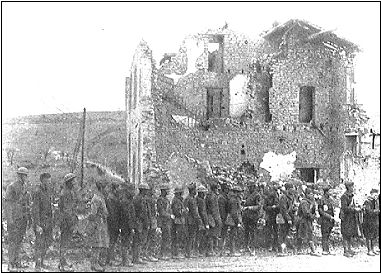
THE HISTORIC SITE OF “LE MORT HOMME”
IN moving to Cuisy it was necessary to pass over the scene of some of the fiercest fighting that took
place during the German attempt to take Verdun, beginning on February 21, 1916. Of special interest
were Hill 304, on the right of the road from Esnes to Malancourt, and Le Mort Homme, a hill to the right
in going from Esnes to Béthincourt. These positions had been the objectives of a fresh attack on April
10, 1916, which was launched with great strength for the purpose of driving out the French batteries
which had very cleverly upset the German attacks on the right bank of the Meuse. The Germans
succeeded in taking both hills, as well as the height of Forges and the woods of Avocourt. From this
vantage-point, the enemy could reach with gun-fire the railway line from Verdun to Ste. Menehould.
Not until more than a year later was this situation relieved. After six months’ preparation, a
counterattack against Avocourt, Hill 304, and Le Mort Homme was launched on August 20, 1917; all of
these objectives were taken and passed, and the French line brought back to the point whence the
Germans started in 1916.
When the 1st American Army attacked on September 26, 1918, the German line was just in
front of Malancourt and Béthincourt. A bird’s-eye view of the progress of the American operations
before the 90th Division entered the sector will be of interest.
The 4th Division, on the left of the 3d Corps, passed Cuisy and entered the Bois de Septsarges by
12:40 P. M. of the first day. The 80th Division, on its right, had gone beyond that and even reached the
Meuse; while the 33d Division, the extreme right of the 1st Army, cleaned out the region between the
right of the 80th Division and the Meuse.
Scene in Cuisy showing Y. M. C. A. Secretary giving chewing-gum to the men on duty.
In the background is the road that leads from Cuisy to Septarges.